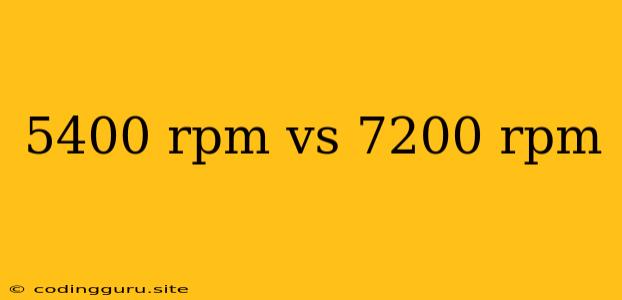The RPM Race: 5400 RPM vs. 7200 RPM Hard Drives
When choosing a hard drive, you'll often encounter the term "RPM," short for revolutions per minute. This refers to how fast the drive's platters spin, directly influencing its performance. But what's the difference between a 5400 RPM drive and a 7200 RPM drive? And which one is right for you?
The Basics:
- 5400 RPM Hard Drives: These drives spin at a slower pace, resulting in lower data access speeds. This translates to longer loading times for applications and files, especially larger ones.
- 7200 RPM Hard Drives: Faster spinning drives deliver quicker data access, resulting in smoother performance and faster loading times. However, this comes at the cost of higher power consumption and potentially more noise.
When to Choose a 5400 RPM Drive:
- Budget-conscious users: 5400 RPM drives are generally more affordable, making them an attractive option for users on a tight budget.
- Low-demand applications: If you mainly use your computer for basic tasks like web browsing, email, and word processing, a 5400 RPM drive may be sufficient.
- Storage-centric needs: For tasks like storing large media files or using your computer as a NAS (Network Attached Storage), where access speed is less critical, 5400 RPM drives can be a cost-effective choice.
When to Choose a 7200 RPM Drive:
- High-performance computing: If you're a gamer, video editor, or software developer, a 7200 RPM drive is crucial for delivering the speed and responsiveness you need.
- Multitasking: Frequent multitasking with resource-intensive applications can benefit greatly from the faster data access of a 7200 RPM drive.
- Boot-up speed: For faster boot times and overall system responsiveness, a 7200 RPM drive will provide a noticeable difference.
Beyond RPM: Other Factors to Consider:
While RPM is a significant factor, it's not the only one to consider when choosing a hard drive. Other aspects play a crucial role:
- Cache size: A larger cache buffer allows the drive to store frequently accessed data, improving overall performance.
- Interface: The interface type (SATA, NVMe) affects data transfer speeds, with newer interfaces offering faster data transfer rates.
- Capacity: Choose a drive with enough storage space for your current and future needs.
- Durability: Factors like shock resistance and mean time between failures (MTBF) can impact the lifespan of your drive.
Conclusion:
The choice between 5400 RPM and 7200 RPM drives boils down to your specific needs and budget. For budget-conscious users with basic requirements, a 5400 RPM drive might suffice. However, for demanding applications or users who value speed and responsiveness, a 7200 RPM drive is the better choice. Remember to consider other factors besides RPM when making your decision.
